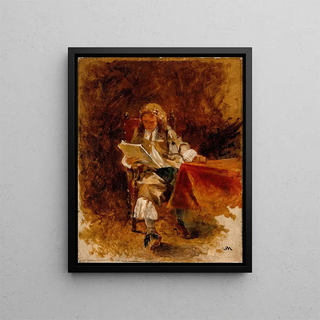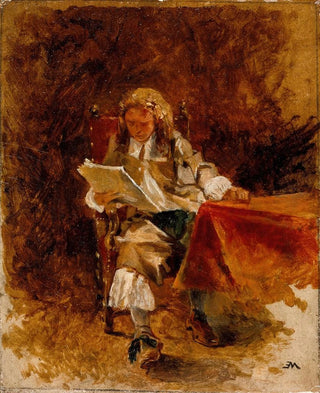Art print Study of a seated rider reading - Ernest Meissonier | Art print


View from behind

Frame (optional)
"Reproduction" Étude of a seated rider reading - Ernest Meissonier – Captivating introduction
The artwork "Study of a seated rider reading" by Ernest Meissonier embodies a delicacy and depth that transport the viewer into the intimacy of a moment frozen in time. This painting, through its composition and subject, evokes not only the art of 19th-century academic painting but also a reflection on culture and knowledge. The scene depicts a rider, immersed in a book, thus highlighting the duality between the external world, full of action, and the serenity of contemplation. This contrast, beautifully captured by Meissonier, invites immersion into a universe where literary escape blends with the nobility of the spirit.
Style and uniqueness of the work
Meissonier's technique is distinguished by meticulous attention to detail and mastery of shadows and lights. In "Study of a seated rider reading," each element is carefully considered, from the textures of the rider's clothing to the subtle reflections of light on the pages of the book. The artist employs a striking realism that transcends simple representation to offer a sensory experience. The colors, though subdued, reveal a rich palette that evokes both warmth and emotional depth. The rider's posture, relaxed yet focused, demonstrates an intimacy with his work, creating a connection between the artwork and the viewer. This stylistic approach, characteristic of Meissonier, makes this study a true masterpiece that still resonates today.
The artist and his influence
Ernest Meissonier, an emblematic figure of academic art, knew how to mark his era with his commitment to rigorous realism and refined aesthetics. Born in 1815, he was influenced by the great masters of the past while developing a personal style that contributed to redefining genre painting. Meissonier captured moments of everyday life with such precision that he became one of the most respected painters of his time. His work, while rooted in a classical tradition, also anticipated future artistic movements, notably the

Matte finish

View from behind

Frame (optional)
"Reproduction" Étude of a seated rider reading - Ernest Meissonier – Captivating introduction
The artwork "Study of a seated rider reading" by Ernest Meissonier embodies a delicacy and depth that transport the viewer into the intimacy of a moment frozen in time. This painting, through its composition and subject, evokes not only the art of 19th-century academic painting but also a reflection on culture and knowledge. The scene depicts a rider, immersed in a book, thus highlighting the duality between the external world, full of action, and the serenity of contemplation. This contrast, beautifully captured by Meissonier, invites immersion into a universe where literary escape blends with the nobility of the spirit.
Style and uniqueness of the work
Meissonier's technique is distinguished by meticulous attention to detail and mastery of shadows and lights. In "Study of a seated rider reading," each element is carefully considered, from the textures of the rider's clothing to the subtle reflections of light on the pages of the book. The artist employs a striking realism that transcends simple representation to offer a sensory experience. The colors, though subdued, reveal a rich palette that evokes both warmth and emotional depth. The rider's posture, relaxed yet focused, demonstrates an intimacy with his work, creating a connection between the artwork and the viewer. This stylistic approach, characteristic of Meissonier, makes this study a true masterpiece that still resonates today.
The artist and his influence
Ernest Meissonier, an emblematic figure of academic art, knew how to mark his era with his commitment to rigorous realism and refined aesthetics. Born in 1815, he was influenced by the great masters of the past while developing a personal style that contributed to redefining genre painting. Meissonier captured moments of everyday life with such precision that he became one of the most respected painters of his time. His work, while rooted in a classical tradition, also anticipated future artistic movements, notably the
12,34 €






